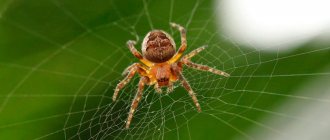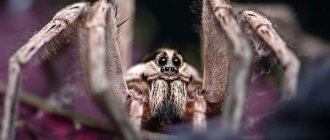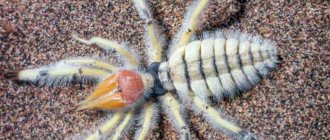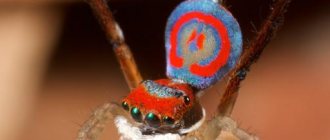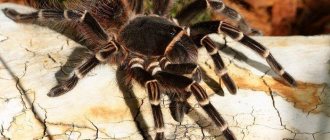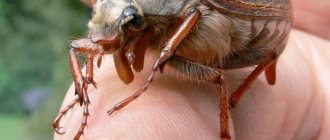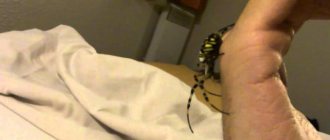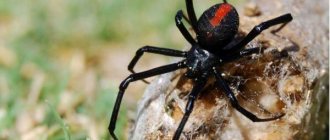General characteristics. External structure
The cross spider can be found in the forest, park, and on the window frames of village houses and cottages.
Most of the time, the spider sits in the center of its trapping network of adhesive thread - cobweb. The spider's body consists of two sections: a small elongated cephalothorax and a larger spherical abdomen. The abdomen is separated from the cephalothorax by a narrow constriction. Four pairs of walking legs are located on the sides of the cephalothorax. The body is covered with a light, durable and quite elastic chitinous cover.
The spider periodically moults, shedding its chitinous cover. At this time it is growing. At the anterior end of the cephalothorax there are four pairs of eyes, and below there is a pair of hook-shaped hard jaws - chelicerae. With them the spider grabs its prey.
There is a canal inside the chelicerae. Through the channel, poison from the poisonous glands located at their base enters the victim’s body. Next to the chelicerae there are short organs of touch, covered with sensitive hairs - the tentacles.
At the lower end of the abdomen there are three pairs of arachnoid warts that produce cobwebs - these are modified abdominal legs.
The liquid released from arachnoid warts instantly hardens in air and turns into a strong web thread. Different parts of arachnoid warts produce different types of webs. Spider threads vary in thickness, strength, and adhesiveness. The spider uses different types of web to build a trapping network: at its base there are stronger and non-sticky threads, and concentric threads are thinner and stickier. The spider uses webs to strengthen the walls of its shelters and to make cocoons for eggs.
Features and appearance
The crusader spider belongs to the orbweaver family. Araneus diadematus is the name of the common cross. It avoids encounters with other arthropods and tries to settle where there are no other representatives of its species. Adults prefer the following places:
- swamps;
- river banks;
- lowlands;
- wet areas of forests;
- edges of meadows;
- lake coasts.
The spider is called differently: crusader, crusader, crusader. Based on this alone, everyone can remember an arthropod with a simple color and a characteristic spotted pattern on the back, forming a figure in the shape of a cross. The shade of the body and head depends on the place where the spider lives.
Individuals with crosses of the following colors are common:
- orange;
- red;
- grey;
- marble;
- almost black;
- yellow.
Some have almost white spots. The four-spotted pattern serves as a message to insects: a bite can be dangerous. The same ragwort can be colored differently: when it lives in a sunny area, the back becomes pale brown, and if it moves to a shady place, the color becomes richer and darker.
Crusaders that live in areas with forbs and a lot of bright flowers take on bright colors.
By merging with the surrounding vegetation, the spider becomes less noticeable to birds that can eat it, and insects that lay eggs directly into the body of arthropods.
The crusader's worst enemy is the fly Melanophora roralis . The insect takes advantage of the fact that the spider is motionless in wait for its prey, flies up, pierces its back and lays eggs.
The sizes of females and males vary. The former reach 10 mm in length, the latter - 20 mm. Some individuals grow up to 26 mm. The body grows during the molting period, when the young individual sheds its chitinous cover.
This species of arachnid has 4 eyes located on its head. thanks to this, the common cross notices prey not only in front of itself, but also to the sides.
The organs of vision are designed in such a way that the arthropod sees objects unclearly, reacting to moving contours or shadows.
The spider with a picture in the form of a cross breathes using lung sacs. The sense of touch is carried out with the help of small hairs that grow densely throughout the body. Thanks to them, the arthropod senses even the slightest vibration in the air nearby, and based on this feature it detects the prey faster, and also better navigates its environment.
The spider with a cross on its butt has 8 legs arranged symmetrically. Each paw has 3 small claws - they are needed to cling to rough surfaces. The spider can move even on smooth surfaces.
At the end of the claws there are thousands of small hairs that can only be seen under a powerful microscope.
Thanks to this structure, interaction with the surface at the molecular level is ensured..
The arachnid is predominantly nocturnal. During the day, the cross is rarely active, preferring to sit out in the grass or leaves of trees, which is why it is sometimes called the “leaf fly.”
Thanks to its color, it does not look noticeable against the background of vegetation. This species is common not only in Russia, but also in Ukraine, where it is known as the “crest spider.” The arthropod can also be seen in Belarus.
Life cycle and reproduction
This type of spider is dioecious: all individuals are divided into males and females. The mating period begins in August and continues throughout the month.
First, the male weaves threads, extending them from the queen's web: this is the path along which he will escape after copulation. After this, the spider visits the partner several times, and only then mating occurs.
When the female is fertilized, she eats the male unless he has time to escape.
The queen lays her eggs in a cocoon woven from spider web threads. It turns out to be a small dense bag, which the arthropod hides in a safe place and protects. Sometimes the queen carries the cocoon with her. The embryos develop from autumn to early spring, after which they are born. By summer, the spiderlings develop into adults, and then the female dies.
In August, young individuals become sexually mature and begin to mate. This happens every year. Life expectancy is about one and a half years for females and the same for males, but the latter have a high risk of being eaten and dying earlier. Adults overwinter as nymphs.
Nutrition composition
The basis of the cross's diet is small insects. In addition to them, the arthropod also eats other representatives of the fauna. Species that the cross spider feeds on:
- aphid;
- flies;
- wasps;
- small beetles;
- fruit flies;
- grasshoppers;
- dragonflies;
- bees;
- mosquitoes
To get food for itself, the spider weaves a strong hunting web. Sometimes insects that are too large are caught in it and are able to pierce the body of the cross and lay eggs in it. In this case, the arthropod breaks the threads so that the dangerous prey can fly away.
The hunt goes like this: the individual hides in a secluded place where the threads from the main web are stretched. When prey gets caught in the net, it begins to make chaotic movements, trying to get out. The vibrations are transmitted to the spider, it approaches the victim and pierces it with its jaw apparatus.
The crusader's digestive system is designed in such a way that food is digested before it enters the spider's body. It injects digestive juice into the prey , after which the digestion process begins.
When the prey's organs dissolve, the arthropod sucks out the semi-liquid contents and becomes saturated. If the cross is not hungry, it does not inject poison into its prey, but kills it and wraps it in a cocoon, then hides it in a place inaccessible to other forest inhabitants.
Danger and benefit
People who are new to the characteristics of the crusader believe that he poses a threat to humans, but this is not entirely true. In fact, the arthropod is deadly to insects, and its bites can cause harm to small animals (rats, mice).
For cows, bulls and horses, an attack by a cross does not pose a threat. They may experience itching and burning in the bitten area, but nothing more. The same applies to people: for them the bite is somewhat toxic, but practically safe.
The affected area itches for some time, but soon the discomfort goes away.
The total number of species of crusaders exceeds 2 thousand, but about 30 varieties are common in Russia. Their reproductive characteristics and life cycles are similar, and the degree of danger is also approximately the same. Spiders rarely bite; most often they do not attack humans.
Nature dictates that large living creatures cannot serve as food. Even if a spider bites, a person does not always feel it. Thus, there is no need to be afraid of him. Do not confuse the cross with the “death’s head”: according to the description, they are similar, but the second one has a pattern on the back that resembles a skull.
Internal structure
Digestive system
The spider's digestive system consists of the mouth, pharynx, esophagus, stomach, and intestines (front, middle and back). In the midgut, long blind processes increase its volume and absorption surface.
Undigested residues are expelled through the anus. The spider cannot eat solid food. Having caught prey (some insect) with the help of a web, he kills it with poison and lets digestive juices into his body. Under their influence, the contents of the captured insect liquefy, and the spider sucks it up. All that remains of the victim is an empty chitinous shell. This method of digestion is called extraintestinal.
Circulatory system
The spider's circulatory system is not closed. The heart looks like a long tube located on the dorsal side of the abdomen.
Blood vessels extend from the heart.
In a spider, the body cavity is of a mixed nature - during development it arises from the connection of the primary and secondary body cavities. Hemolymph circulates in the body.
Respiratory system
The spider's respiratory organs are the lungs and trachea. The lungs, or pulmonary sacs, are located below, in the front of the abdomen. These lungs developed from the gills of the distant ancestors of spiders that lived in water.
The cross spider has two pairs of non-branching tracheas - long tubes that deliver oxygen to organs and tissues. They are located in the back of the abdomen.
Nervous system
The spider's nervous system consists of the cephalothoracic nerve ganglion and numerous nerves extending from it.
Excretory system
The excretory system is represented by two long tubes - Malpighian vessels. One end of the Malpighian vessels ends blindly in the body of the spider, the other opens into the hind intestine. Harmful waste products come out through the walls of the Malpighian vessels, which are then excreted. Water is absorbed in the intestines. In this way, spiders conserve water so they can live in dry places.
Appearance
The abdomen itself is rounded with no segments. If you look at its lower part, you can see 3 pairs of arachnoid warts, which contain about a thousand glands. It is the glands that are responsible
for the production of webs for a variety of purposes: to build a trap, weave a cocoon, or to create a shelter.
Female size
exceeds the size of the male. For example, the body length of a female is 17–40 mm, and that of a male.
10–11 mm. This type of cross has a body cavity of a mixed type or, in other words, a mixocoel. This cavity was formed as a result of the merger of the primary and secondary cavities. The body of the crusader is covered with a yellow-brown chitinous shell. During molting, the cross
sheds the shell, thereby renewing the chitinous layer.
The cross has 10 limbs:
The cross spider has very poor eyesight, despite the fact that it has 4 pairs of eyes. This spider distinguishes only light, shadow and blurred silhouettes. But this does not prevent him from having excellent orientation in space, because he has a well-developed sense of touch. It is carried out thanks to tactile hairs covering the body. Every type of hair
has its own function: some perceive sound, others detect changes in air movement, and still others react to various kinds of stimuli.
The lifespan of a spider is from 1 to 2 years and depends on the type of crusader.
Respiratory organs and heart
The crusader breathes using his abdomen, because the organs responsible for this important function are located there. Respiratory organs are presented
in the form of a pair of pulmonary sacs with numerous leaf folds. They contain air and hemolymph circulates, while being enriched with oxygen. This name refers to the fluid that flows in the vessels instead of blood. The respiratory organs of the cross also include trachea-tubes, collected in two bundles. They open through a hole located at the bottom of the abdomen.
The heart, in the form of a long tube, is located in the dorsal part of the abdomen. Large vessels will withdraw from the heart
.
Excretory system and digestion
The excretory system is presented as:
- Coxal glands. A system of canals departs from them, which ends in the form of excretory ducts in the area of the base of the walking legs.
- Malpighian tubes. With their help, metabolic products leave the crusader's body.
Digestion in the cross spider is external. In other words, the crusader’s body is not able to digest food, so it builds traps from cobwebs.
Features of the web
The crossers are updating their web
almost every day, due to the unsuitability of the old one. The reasons why a spider needs to change its web are:
- Gaps due to prey being trapped.
- Holes caused by large insects that are unsuitable for spider feeding.
The web is being weaved
at night. This is explained by the fact that at night the crossbird feels completely safe, because birds that feed on insects have been sleeping for a long time. The new prey trap will be ready for use in the morning.
The spider has a scheme for weaving a web, laid down at the genetic level. The web always has a certain number of circles and spirals, and the spaces between the weaves are the same. Young males build webs no worse than adults until they reach sexual maturity.
Reproduction
Spiders begin to mate in the autumn season. A male who has reached sexual maturity
, goes in search of a female who is waiting for him in her weaving. As soon as the spider has found its chosen one, it attaches a thread to its web, as if inviting it to itself. For the female, this means that it is time to reproduce and she leaves her network. The male representative dies after mating.
In turn, the fertilized female builds a cocoon where she will subsequently lay her eggs. For several days the cocoon is under the protection of the mother. The female then finds a secluded place in the cracks of the walls, in which the cocoon survives the winter. The female dies, and spiders emerge from the cocoon in the spring. In summer, the new offspring are ready to reproduce.
Reproduction. Development
Fertilization in spiders is internal. The female cross spider is larger than the male. The male transfers sperm to the female's genital opening using special outgrowths located on the front legs.
She lays eggs in a cocoon woven from a thin silky web. The cocoon weaves in various secluded places: under the bark of stumps, under stones. By winter, the female cross spider dies, and the eggs overwinter in a warm cocoon. In the spring, young spiders emerge from them. In the fall, they release cobwebs, and on them, like parachutes, they are carried by the wind over long distances - the spiders disperse.
Reproduction
In the fall, male crossworts begin to look for a mate for procreation. Interestingly, the spider finds the female’s web and weaves a thread there,
which will signal to the lady that the potential father of her future children has come to her. In addition, the thread serves as an escape route, along which the male runs away from the female in a critical situation. The spider does not immediately accept her new groom.
Important! After the act of love, the male dies. The female eats it: she needs strength, and it is best for those who are nearby to refresh herself. It doesn’t always work out this way; some cross members successfully avoid a sad fate.
After fertilization, the female lays eggs in a special cocoon. For several days she keeps the future offspring close to her and hides them in a quiet and peaceful place. This could be a crack in the wall or a crevice under the bark of a tree. The spiderlings spend the winter quietly and are born in the spring. In summer, young crosses can already reproduce.
The spider lays about 800 eggs.
They resemble amber in color. The cocoon reliably protects the offspring from hypothermia in winter and spring. Not all spiderlings will survive. Someone will be eaten, someone will die without food. Therefore, young crossers are in a hurry to find their place in the sun. They move around the territory using webs. With gusts of wind, the thread can carry the cross up to 400 km.
When the web falls to the ground, the cross immediately begins to act, settling in a new place.
External structure and nutrition of arachnids
In spiders, the body segments merge to form the cephalothorax and abdomen, separated by an interception.
The body of arachnids is covered with a chitinized cuticle and underlying tissue (hypodermis), which has a cellular structure. Its derivatives are arachnoid and poisonous glands. The venom glands of the cross spider are located at the base of the upper jaws.
A distinctive feature of arachnids is the presence of six pairs of limbs . Of these, the first two pairs - the upper jaws and the tentacles - are adapted for capturing and grinding food. The remaining four pairs perform the functions of movement - these are walking legs.
External structure of arachnids
During embryonic development, a large number of limbs are formed on the abdomen, but later they are transformed into arachnoid warts , opening by the ducts of the arachnoid glands. Hardening in air, the secretions of these glands turn into spider threads, from which the spider builds a trapping network.
After the insect has fallen into the net, the spider envelops it in a web, plunges the claws of its upper jaws into it and injects poison. Then he leaves his prey and hides in cover. The secretion of the poisonous glands not only kills insects, but acts as digestive juice. After about an hour, the spider returns to its prey and sucks out the semi-liquid, partially digested food. From a killed insect, only one chitinous cover remains.
Cross spider. Lifestyle and habitat of the cross spider
Features and habitat of the cross spider
The cross spider belongs to the orb weaver family. The spider was given such an unusual name because of the large noticeable cross on its back, formed by light spots.
The abdomen of the “flycatcher” is of a regular round shape, most often brown, but there is also a white cross , whose abdomen is light yellow or beige. Long legs are very sensitive to the slightest vibrations of the web.
The cross spider has arranged so that the insect has a 360-degree view. However, its vision leaves much to be desired; the spider can only see shadows and vague outlines of objects.
species of cross spiders - about 2000, only 30 of them are found in Russia and the CIS, and all can boast of a pronounced cross on the upper part of the abdomen.
The size of a female individual can vary from 1.5 to 4 centimeters (depending on the specific species), while the size of a male individual can vary from 1.5 to 4 centimeters. Another surprising thing is the mixed cavity of the insect’s body - the myxocoel, which appeared as a result of the connection of the primary cavity with the secondary one.
One of the most common types is the common cross. The female of this species can reach 2.5 centimeters in length, the males are much smaller - up to 1 centimeter. The abdomen of males is quite narrow, while that of females is large and round. The color may change slightly, adjusting to the lighting at a given time.
The spider's body is covered with special wax, which helps retain moisture. The female cross spider has reliable protection - a cephalothorax shield, on which the eyes are located.
Preferred habitats are always quite damp and humid. These can be forests, fields and meadows near swamps and ponds, groves, gardens, and sometimes human buildings.
The character and lifestyle of the cross spider
Most often, the spider chooses the crown of a tree for its permanent place of life. Thus, he immediately creates both a trapping net (between the branches) and a shelter (in the thick leaves). The web of the cross spider is clearly visible even at some distance; it is always round and even and quite large.
The household crossmaker carefully monitors the condition of the threads in the web and makes sure to completely renew it every few days. If a large web becomes a trap for an insect that the spider cannot handle, it breaks the threads around its prey and removes it.
Replacing an old trap with a new one most often occurs at night, so that by morning it is ready for hunting. This distribution of time is also justified by the fact that at night the spider’s enemies sleep and pose no danger; the spider can do its work calmly.
It would seem how an almost blind spider can build such complex structures in complete darkness! However, in this case it is based not on vision, but on touch, which is why the network is always so smooth. Moreover, the female weaves the net according to strict canons - it always maintains the same distance between the turns, there are 39 radii, 35 turns and 1245 connecting points.
Scientists have found that this ability is inherent at the genetic level; the spider does not need to learn this - it performs all movements unconsciously, automatically. This explains the ability of young spiders to weave the same web as adults.
The consequences of a spider bite can be unpredictable, since its venom is toxic not only to insects, but also to vertebrates. The poison contains hemotoxin, which has a negative effect on the red blood cells of animals.
Internal structure of arachnids
The respiratory system of the cross spider is represented by pulmonary sacs and trachea. The pulmonary sacs and trachea of arachnids open outwards with special openings on the lateral parts of the segments. The pulmonary sacs contain numerous leaf-shaped folds in which blood capillaries pass.
The trachea is a system of branched tubes that connect directly to all organs where tissue gas exchange takes place.
Internal structure of arachnids
The circulatory system of arachnids consists of a heart located on the dorsal side of the abdomen and a vessel through which blood moves from the heart to the front of the body. Since the circulatory system is not closed, blood returns to the heart from the mixed body cavity (mixocoel), where it washes the lung sacs and trachea and is enriched with oxygen.
The excretory system of the cross spider consists of several pairs of tubes (Malpighian vessels) located in the body cavity. Of these, waste products enter the posterior intestine.
The nervous system of arachnids is characterized by the fusion of nerve ganglia with each other. In spiders, the entire nerve chain merges into one cephalothoracic ganglion. The organ of touch is the hairs covering the limbs. The organ of vision is 4 pairs of simple eyes.
Cross spider - description, characteristics, structure
The cross spider is a fairly small spider, however, females are much larger than males: their length ranges from 1.7 to 4 cm, and the size of males is from 1 to 1.1 cm. The body of the cross spider is covered with a chitinous shell of a yellowish-brown color, which is reset during the next molt.
Like most arachnids, the cross spider has 10 limbs:
- 4 pairs of walking legs, at the ends of which there are claws,
- 1 pair of pedipalps, which perform the function of recognizing and retaining prey,
- 1 pair of chelicerae, which are needed to capture and kill prey. The spider's chelicerae are directed downward, and their hooks are directed inward.
Photo by: Alvesgaspar
On the last segment of the pedipalps in adult males there is a copulatory organ, which, before mating, is filled with seminal fluid and inserted into the spermatheca of the female.
Chelicerae of the cross. Photo by: Mike
The cross spider has 4 pairs of eyes, although it sees very poorly and distinguishes only blurry silhouettes, light and shadow. This deficiency is more than compensated for by a well-developed sense of touch, represented by tactile hairs scattered over the entire surface of the body.
Some hairs react to chemical stimuli, others perceive air vibrations, and others pick up sounds.
Photo by: Mike
The abdomen of the cross spider is round and devoid of segments, its upper part is decorated with a cross.
On the lower part of the abdomen there are 3 pairs of arachnoid warts containing about a thousand glands that produce threads for various purposes: for building trapping nets, arranging a shelter, weaving a cocoon.
Photo by: Michael Gäbler
Cross spiders, like most spiders, have external digestion: they are unable to digest food themselves, so they are forced to build trapping networks. The cross spider injects digestive juice into the victim it encounters, wraps the prey in a web cocoon and waits until the “dinner” is digested and turns into a nutrient solution that can be drunk.
The respiratory organs of the cross spider are located in the abdomen. They are represented by a pair of pulmonary sacs with a large number of leaf-like folds. There is air inside the folds, and hemolymph circulates through them (this is the name of the liquid that is found in the vessels of spiders instead of blood), enriched with oxygen. In addition to the pulmonary sacs, the respiratory organs include two bundles of trachea-tubules, which open with a hole on the underside of the abdomen.
Araneus viridiventris
The circulatory system of the cross spider is not closed. The heart is located in the dorsal part of the abdomen, in appearance it resembles a long tube, large blood vessels extend from it. From the anterior end of the heart, which has three pairs of holes, ostia, the anterior aorta departs, branching into arteries. The terminal branches of the arteries pour hemolymph into the body of the spider, which washes all the internal organs of the spider, transporting oxygen and necessary nutrients to them.
When hemolymph circulates through the pulmonary sacs, gas exchange occurs, then the hemolymph enters the cardiac pericardium and through the ostia into the heart itself. The hemolymph of the cross contains a copper-containing pigment - hemocyanin, which has a blue color.
Crosswort Araneus marmoreus. Photo by: PiccoloNamek
The excretory system of the cross spider is represented by coxal glands and malpighian vessels. Malpighian vessels in the form of tubes are nothing more than blind protrusions of the intestine, and they open into the intestine of the spider, located between the midgut and hindgut. They allow metabolic products to be absorbed from the body cavity of the cross.
The coxal glands are a pair of sac-like structures located in the cephalothorax. A system of canals departs from them, which ends with excretory ducts at the base of the walking legs.
Araneus circulissparsus. Photo by: Donald Hobern
The life cycle of the cross spider, depending on the species, is about 1-2 years.
Reproduction of arachnids
All arachnids are dioecious. The female cross spider lays eggs in the fall in a cocoon woven from a silky web, which she places in secluded places (under stones, stumps, etc.). By winter, the female dies, and spiders emerge from eggs overwintered in a warm cocoon in the spring.
Other spiders also take care of their offspring. For example, a female tarantula carries her young on her back. Some spiders, having laid eggs in a web cocoon, often carry it with them.
Among the arachnids there are species whose poison is dangerous for humans and farm animals (karakurt, scorpion), human parasites (itching itch) and mites that carry pathogens that are painful to humans and animals (taiga tick, etc.).
Pavuk khrestovik
The spider spider is classified as an arthropod, a representative of the spider-like class. Pavuk-khrestovik his zdobich to catch for additional pavutini. The spinning apparatus of spiders is made up of external structures - spider warts - and internal organs - spider veins. Three pairs of spider web warts grow on the back end of the petiole. This skin wart is pierced at the end with a hundred different openings. From the skin opening a speck of sticky thread is woven, like a spider weaving into the thinnest thread in Russia. These threads become angry and thicken in the wind. The result is a thin, scarlet thread. This kind of glue can be seen in numerous cobwebs growing in the back of the stalk. Ducts open on their spider warts.
Arachnids
This net has over 100,000 of these little dots. Mosquitoes stick to them with their wings and paws and swoop down on the edge. The spider itself either hangs head down in the center of the spider web, or hangs to the side under the leaf. In this case, a signal thread is stretched to itself from the center of the web.
When a housefly gets caught in the middle, the spider, having sensed the three-ton signal thread, rushes out of its hiding spot. With open claws, the spider kills the victim and sees herbal juices in its body. After which he wraps a fly or another mosquito with cobwebs and deprives it for an hour.
Under the influx of herbal juices, the internal organs of the spider's victim are quickly poisoned. After about an hour, the spider turns to the victim and extracts all the living words from it. As mosquitoes in the web lose only their empty chitinous covering.
A prepared trap is a series of unrelated actions interconnected. The passion for such actions is instinctive and is transmitted spasmodically. It’s easy to overcrowd, following the behavior of young spiders. If the smell comes out of the eggs, no one will recognize them as working as a catcher, but the spiders will immediately smell the spider.
Budova pavuka-khrestovika
The cross spider is the most common creature of our forests. This spider, which is yellowish-brown or even blackened with bark, can be easily recognized by the white cross-like flame on the dorsal side of the body. These peculiarities of this type are called chrestovika. His zabarvlennya may be of the greatest significance; there is no way to stop him in the dark in the middle of the thick tea leaves, between the bushes of the trees.
With these signs of the future, the cross spider predicts the crayfish, and at the same time reveals a number of features associated with a different way of life. The class of spider-like creatures changed during the gradual transition from an aquatic to a terrestrial way of life. Like the crayfish, the body of the spider-like class (the spider spider) consists of two sections: the cephalothorax and the petiole. The ale stalk is very swollen and undifferentiated. In contrast to crustaceans, there are no whiskers on the head of the spider spider. The spider spider, like the tick, has no folding eyes. On the upper side of the head there are very simple glasses, and on the lower side, near the mouth, two pairs of slits. Spiders are tiny creatures. The stinks are grubby the mosquitoes. With the front pair of slits, the spider drives the bean. At the base of the cracks there are ruined vines. When the claws that end the cracks crash into the wound, the cuttings flow into the wound and kill the victim.
With another pair of slits, the spider grazes the zdobich. Behind the cracks there are rotted pairs of long walking legs. Like crayfish, the spider's legs are folded into round joints. The skin of the leg ends in jagged claws, so the spider can run on its net without getting lost in it. Claws also help spiders weave cobwebs. When replacing crayfish with brooches, there are no endings.
